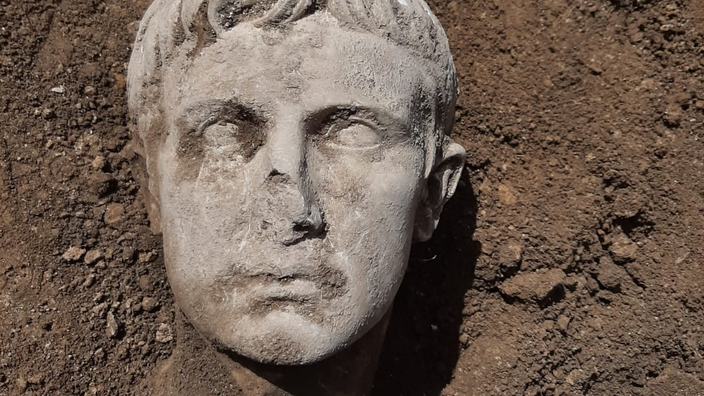The face does not deceive.
Idealized, Apollonian features and a pair of curved frontal locks.
The marble portrait unearthed by Italian archaeologists in the municipality of Isernia, in Molise, in all likelihood represents Augustus, the first emperor of Rome.
"Yes, it is he ... the Emperor Augustus"
, declared in a press release the archaeological superintendency of Molise in charge of the excavation.
35 centimeters high, it would have belonged to a statue a little over 2 meters high, dated around 20 BC.
AD to 10 AD.
J.-C .. A real little treasure for this city of 21,000 inhabitants.
Read also: In Rome, the rebirth of the Mausoleum of Augustus, witness to a turbulent history
Damaged, in particular to the nose, as is often the case with statues, this head, frozen in a very slight twist, was found near the old city wall. It corresponds, in a completely archetypal way, to the type of portrait known as the Prima Porta, from the name of the masterpiece kept in the Vatican Museums which offers the most widespread model of representation of the sovereign. The grand-nephew of Julius Caesar, raised in 27 BC. AD in the rank of
Augustus
and
Princeps
, is
"clearly identifiable thanks to the features of his face and his hair, carrying a characteristic forked lock"
, specified for the local media IsNews Dora Catalano and Maria Diletta Colombo, respectively Superintendent and head of the archaeological office of the Superintendency of Molise.
1/2 - The details of the face and the hair leave little doubt as to the identification of the subject.
Soprintendenza Archeologia, Belle Arti e Paesaggio del Molise
2/2 - The head still partly buried.
Soprintendenza Archeologia, Belle Arti e Paesaggio del Molise
Of Samnite origin, the ancient city of Aesernia entered the orbit of Rome at the beginning of the 3rd century BC. J. - C. and is equipped with a wall shortly after, from 263, at the time of its elevation to the rank of Latin colony. Could the head of Augustus have belonged to a decorative element of this ancient city wall, near which it was unearthed? It is too early to decide, retort the two persons in charge of the excavation:
"We cannot say more for the moment because, as it is about a recent discovery, we must still continue the excavation before understanding in what extent did it fit into the history of this part of the city ”
.
Despite this customary caution, Maria Diletta Colomba has lent herself, on this subject, to the game of possible avenues for CNN.
"It could have been placed in a temple dedicated to the worship of the imperial family, or in the forum
," she said.
But these are only hypotheses, since we do not know where the forum was ”
.
Read also: The colossal bronze of the Emperor Constantine in Rome finds his lost index, it was in the Louvre
A remnant of Isernia's ancient past
Located at an important crossing point in the middle of the Apennines, the ancient city of Aesernia was devastated during the Social War between Rome and a league of Italian cities from 91 to 88 BC. J.-C .. At the time of Augustus, between the end of the 1st century BC. AD, and the beginning of the 1st century AD, the city is no longer a regional center of secondary importance.
"Isernia has a very old history
,
"
city mayor Giacomo D'Apollonio (Fratelli d'Italia) told CNN.
"There are archaeological remains under the whole city"
. The various objects exhumed from the preventive excavation campaign, including the Augustan head and terracotta fragments, should join the collections of the Municipal Archaeological Museum of Santa Maria delle Monache.
The area excavated by researchers from the Molise Regional Archaeological Superintendence, along the Via Occidentale, corresponds to a section of the medieval wall of Isernia. Built over the Roman wall, this section of the city's fortifications collapsed in 2013 following a landslide. The repeated delays and the conservation choices made around this long-term project have been the subject of heated discussions within the municipality for several years. Finally started in March, eight years after the accident, the preventive excavation of the sector must precede the realization of the restoration work itself. For the Superintendency, the discovery of the imperial head already offers
"the best answer to the instrumentalised controversies"
, and the opportunity to hope, 2000 years after Augustus, the return - for a time at least - of a form of local Pax Romana around the ancient heritage of the centuries-old city of Isernia.

